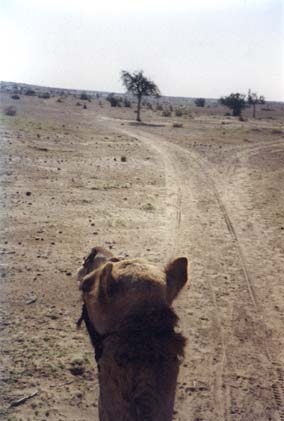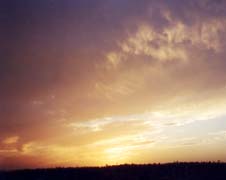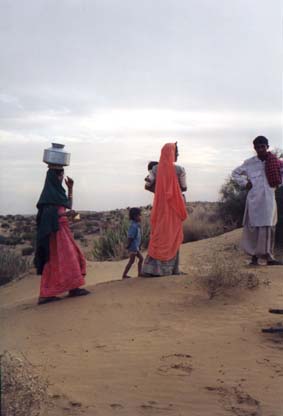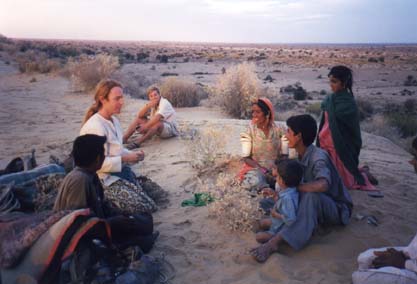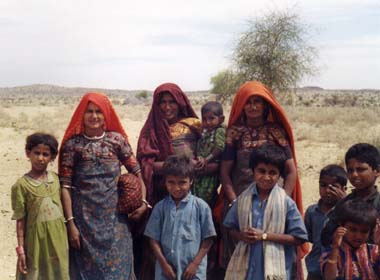|
Camel Contact, Part 2 The embers of last night's campfire are quickly coaxed to life, and soon water for tea is bubbling furiously. After a light breakfast, we bob down the sand dunes on camel's back.
We come to a collection of small round earthen houses with thatch roofs. A family watches us from behind the smooth, rounded desert-colored wall that encloses their yard.
They seek medical advice for an elderly woman who rubs her eye, which is red and dripping tears. She is one of many people I will meet with eye problems. I suggest eye drops and a visit to an eye doctor, both of which are lacking in the midst of the Thar Desert. We take our leave, and ride on across the sand, Rickety-rocking on a camel's back. Squeak of the saddle.
There's a dog following alongside, its tongue hanging out, panting across the desert and hoping for a handout. The sound of the wind speaks of the open space we're in.
The view from our campsite the second night of the safari is transcendental. We're nestled in a shallow dip on a low ridge, with a view east of plowed fields, cacti, a small village, and in the distance the dunes we camped on the previous night. To the west, a tree on a ridge is framed by a sky that starts pink, explodes into an ecstatic orange, then trickles off to white, then blue, then gray clouds on a gradually-darkening sky. Click here to see a panoramic view of the sunset. A woman from the nearby village brings a bottle of local moonshine she has brewed up, made by boiling various fruits with brown sugar in water for 3 or 4 days.
She's wearing the orange sari in this picture. Her face is lined with stories I don't know but would love to hear. Jason brings the bottle over and passes it around. It burns, tastes of fruit, like some distant cousin of tequila. From somewhere beyond the welcome blanket of desert solitude comes the muted tinkle of bells around goats' and camels' necks, and the joyous walking-the-Earth singing of farmers.
I perform magic for the woman who brought the moonshine and her family. At dinner, I stare at the cooking fire, gaze into the dancing flame and at the glowing embers. I marvel at our guides and the local villagers as they knead the chapati dough, pat it into pancakes, place it on an iron pan and then remove it to the edge of the fire, where it puffs up like a balloon, its edges gently crisping in the radiating heat. A chapati is a thick tortilla made from flour and water, with salt and herbs added on occasion. It is a staple of the Indian diet; a torn chunk of it serves as a spoon to eat dal, a spicy lentil soup that comes in thick and watery versions and is another mainstay of Indian cuisine. The dog that padded alongside our caravan throughout the day is rewarded with scraps from the dinner plate. The camels return from their voracious foraging and mingle with us. At night, we sleep in the company of camels. Their sphinx-like silhouette is all that's visible in the moonlight, but their aural and olfactory presence is another matter altogether. They digest their high-fiber diet of wood and leaves throughout the night, a constant loud moist crunching. Now and then they pause for a few seconds, but the silence is invariably broken by a low gurgling roll like vomit rising in their long neck, probably more food brought up to their mouth and that pink organ in their neck for more complete chewing and digestion. From time to time an acrid smell, enough to cause loss of consciousness, wafts across the dunes -- camel breath. The following morning the woman who shared her moonshine brings a large chapati. It's the best chapati I've ever had -- thick and substantial, moist, with a taste of rock salt and herbs. Heavenly, cooked on a once-cast, many-times-camp-fired iron pan. After breakfast we break camp, aiming to cover some ground before the heavy heat of midday sets in.
A few of the many friendly villagers of the Thar desert. Markus, the quiet Swiss guy, falls ill. He has heat stroke, and his white skin is even more pale than normal. The camel caravan halts. Markus rests and drinks as much water as he can keep down, then the guides push on towards their village, the subject of much conversation and promise. Markus chooses the firmness of the Earth over the wobbly wooziness of a camel ride, and walks silently alongside his camel. We top a low ridge. Our guides' village is visible in the distance. Markus lies down weakly in the shade of a scraggly tree. The guides go off on their own, and return an hour later with two camels. It turns out that our camels are all male, and they've brought two female camels from their village to share with us the spectacle of camel sex. Not the visual spectacle, but the sound, is here ... if you haven't eaten recently ... The spectacle is loud and lurid, sprinkled with frothy stomach expulsions. The female camels appear much less willing participants than the males. When we discover that the unexpected show is for our benefit and quickly disintegrating into forced copulation (if our interpretation of camel emotions are accurate), we stop watching and the exhibition soon ends. The safari comes to a close later that day with a jeep ride back to Jaisalmer. |


